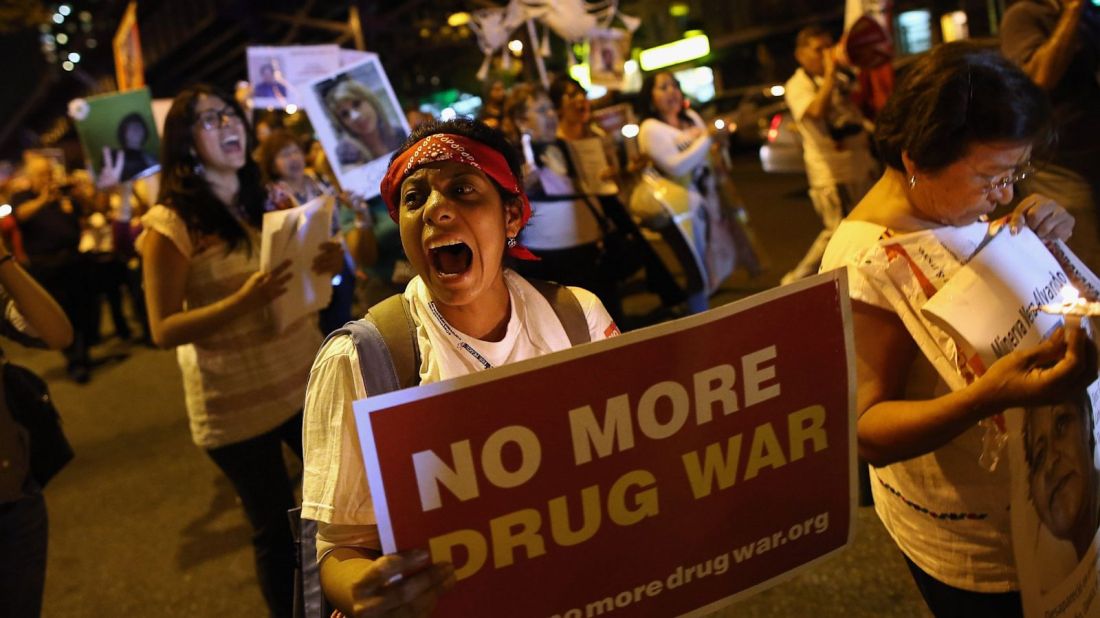Thousands of elementary, middle, and high schools across the nation are gearing up to celebrate Red Ribbon Week with a classroom door decorating and photo contest. Other schools may use the extensive list of resources available at redribbon.org to take the annual event to deeper and perhaps more meaningful levels. But every October, I feel hesitant to fully embrace this widely popular drug prevention campaign. This year’s Red Ribbon Week theme seems straight forward enough, “Life is your journey. Travel drug free.” What possible critique could a classroom teacher have of such an obviously positive program?
For starters, Red Ribbon Week was born out of the “war on drugs” and Nancy Reagan’s “Just Say No” campaign. Nancy Reagan was an Honorary Chair of the National Federation of Parents for Drug Free Youth when the organization began in 1980, the same year Ronald Reagan was elected President. When NFP launched Red Ribbon Week in 1985, the mass incarceration effort of the Reagan administration, fueled by mandatory minimums for non-violent drug offenses, was in full swing. At best, “Just Say No” is now used as a meme characterizing an incredible level of ineffectiveness. At worst, those three little words symbolize almost 50 years of failed drug policies and a calculated campaign of assault on black and brown lives, the legacy of which continues today (see the film 13th).
When National Family Partnership launched Red Ribbon Week in 1985, the mass incarceration effort of the Reagan administration, fueled by zero tolerance policies toward non-violent drug offenses, was in full swing.
Nowhere on the Red Ribbon Week website could I find anything critical of either the “war on drugs” or “Just Say No.” Certainly, drug prevention education has evolved over the last 30 years, and Red Ribbon Week resources reflect some of that, but to stand firmly on the legacy established by Nancy Reagan is problematic to say the least. Even D.A.R.E., the top-down, police driven, extreme scare tactics wing of drug prevention, has distanced itself from “Just Say No.” It is disingenuous for Red Ribbon Week to exist as a drug prevention and awareness campaign without including a comprehensive critique of mass incarceration and the dire need for criminal justice reform in the United States.

What is also not reflected in the resources provided for Red Ribbon Week is the ongoing sweeping decriminalization and legalization of marijuana. Despite 30 states passing “medical marijuana” laws, the Drug Enforcement Agency (DEA) continues to list marijuana as a schedule 1 drug with no “accepted medical use.” Much like the policies of the U.S. government, drug prevention campaigns like Red Ribbon Week continue to misrepresent the science and data related to marijuana use among adults.
For instance, the 2018 Red Ribbon Week infographic shown below includes the statement, “The THREE most widely used drugs by youth and adults: alcohol, prescription drugs and marijuana.” The implication is that these three drugs represent comparable threats to the health and well-being of young people. The truth that the Red Ribbon Week infographic conveniently omits is that annually there are reported alcohol and prescription drug related deaths combined ranging in excess of 100,000. Marijuana related deaths, on the other hand, (though the exact number is debated) is arguably in the single digits. Which begs the question, what would a drug prevention curriculum that is honest about the history, science, and politics of marijuana look like?

Sprinkled in the Red Ribbon Week curriculum and tools for grades 6-8 are a few resources specifically related to addiction. The majority, however, can be categorized roughly as either drug awareness (shocking facts and interesting drug names) or decision making (life skills). The aim of these resources is to push for complete drug abstinence, a more nuanced form of drug prevention compared to “Just Say No,” but strict abstinence nonetheless. To be sure, young people should not be using alcohol, tobacco, marijuana, and a host of prescription opioid medications. But the facts are that many adults try various illicit drugs and do not create patterns of behavior leading to addiction and continue living productive lives. And students deserve the facts.
Students deserve the knowledge of the racial and economic injustice built into the very fabric of drug policy enforcement. Students deserve to know that they may or may not be genetically predisposed to drug addiction. Students deserve to know about the recent rise of supervised injection sites. Students should study the emerging science confirming addiction as a disease, and therefore something to be treated instead of punished. Students deserve the honesty and integrity that comes with a curriculum focused on harm reduction over abstinence. The outdated practices of traditional drug prevention programs like Red Ribbon Week need either to be replaced entirely or made susceptible to major reform.

No comments:
Post a Comment
Note: Only a member of this blog may post a comment.